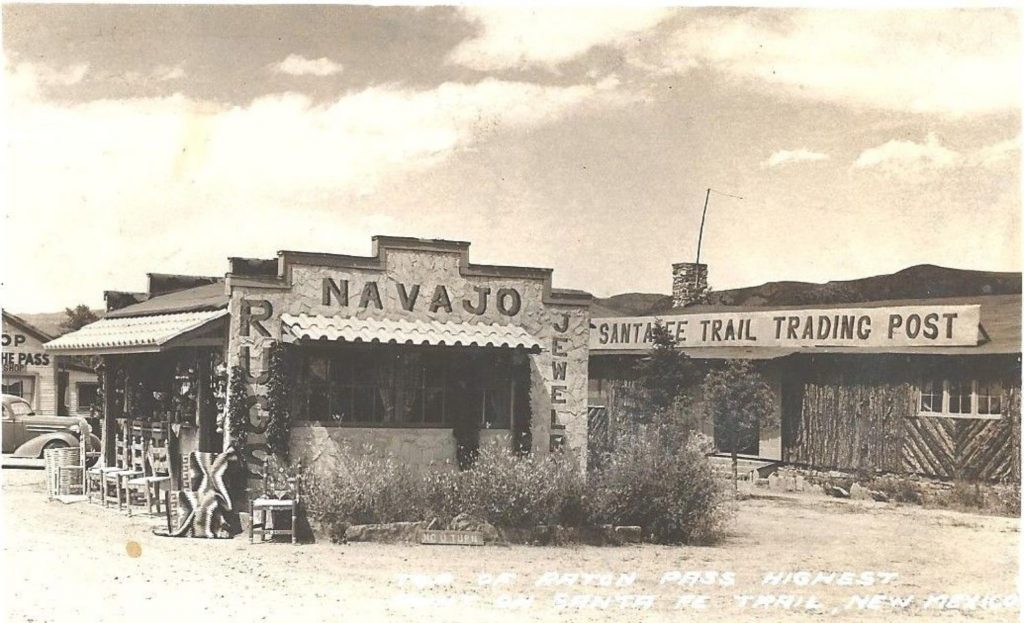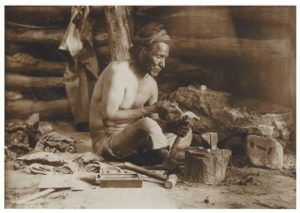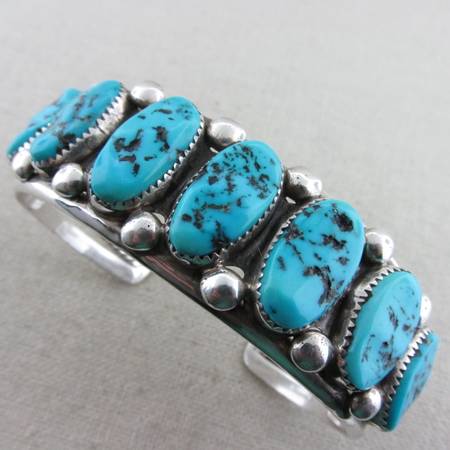 First of all, the Navajo, or Diné, begin working silver in the 19th century. Most noteworthy, Atsidi Sani, or “Old Smith,” (c. 1828-1918) may be the first Navajo blacksmith and the first Navajo silversmith. Subsequently, he learns to work silver from a Mexican smith as early as 1853. As a result, Navajo metal smiths make buckles, bridles, buttons, rings, canteens, hollow beads. Plus, they make earrings, crescent-shape pendants (“najas”). In addition, they make bracelets, crosses, powder chargers, tobacco canteens, and disks, aka “conchas” or conchos” Consequently, they typically use conchos to decorate belts. In addition, they make conchos from copper, steel, iron, and most commonly, silver.
First of all, the Navajo, or Diné, begin working silver in the 19th century. Most noteworthy, Atsidi Sani, or “Old Smith,” (c. 1828-1918) may be the first Navajo blacksmith and the first Navajo silversmith. Subsequently, he learns to work silver from a Mexican smith as early as 1853. As a result, Navajo metal smiths make buckles, bridles, buttons, rings, canteens, hollow beads. Plus, they make earrings, crescent-shape pendants (“najas”). In addition, they make bracelets, crosses, powder chargers, tobacco canteens, and disks, aka “conchas” or conchos” Consequently, they typically use conchos to decorate belts. In addition, they make conchos from copper, steel, iron, and most commonly, silver.
Navajo Silversmith with primitive tools
Furthermore, early Navajo smiths rocker-engrave, stamp, and file designs into plain silver, coins, flatware, and ingots, which they obtain from European-American traders. Later, they acquire sheet silver and wire from American settlers, which they make into jewelry. As a result, the punches and stamps in use by Mexican leather workers become the first tools to create these decorations. Still later, railroad spurs, broke files, iron scraps and, later, piston rods become hand craft stamps in the hands of these skilled artisans. In addition, commercial stamps became available. Finally, they use other traditional hand tools for jewelry construction.
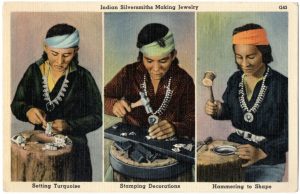
Most noteworthy, the bellows consists of a skin bag about a foot long, held open with wooden hoops. Furthermore, it has a valve and a nozzle. The silversmith uses a forge, crucibles, an anvil, and tongs during the melting process. In addition, molds, the matrix and die, cold chisels, scissors, pliers, files, awls, and emery paper also come into play.
A soldering setup, consisting of a blowpipe and a torch made of oil-soaked rags with borax. The silversmith uses a grinding stone, sandstone dust, and ashes for polishing the jewelry, and a salt ” almogen” for whitening. Additionally, Navajo jewelers begin sand casting silver around 1875. Namely, the silversmith melts silver and pours it into a sandstone mold. Consequently, when cool, the piece normally requires additional filing and smoothing. In addition, sometimes the silversmith engraves cast jewelry.
Above all, people associate the with Navajo jewelry, but it was not until 1880 that the first turquoise is set in silver. On the positive side, turquoise becomes much more readily available in ensuing decades. Additionally, coral and other semi-precious stones come into common use around 1900.
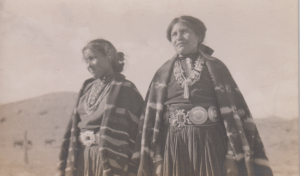
Indeed, one of the most important forms of Navajo and Southwestern Native American jewelry, is the Squash Blossom Necklace. As a matter of fact, most are made of a string of plain round silver beads, interspersed with “squash blossoms”, and feature a pendant, or “naja.” Equally important, the naja hangs from the center of the strand. In addition, the squash blossom beads are copied from the buttons which held together the pants worn by the Spanish, and later, Mexican caballeros. As a matter of fact, these buttons represent pomegranates.
Most importantly, you can find their origin a continent, and several hundred years away, as a traditional part of Spanish horse halters.
Tucson Indian Jewelry offers a HUGE selection of Navajo Jewelry! To see some examples, click HERE!
Portions of Information furnished by Wikipedia.org ©
